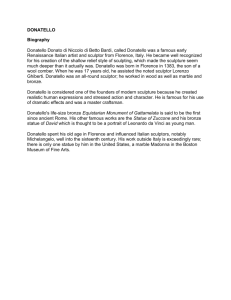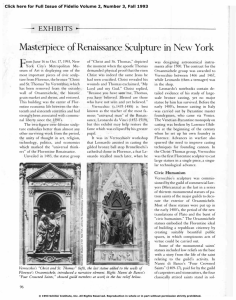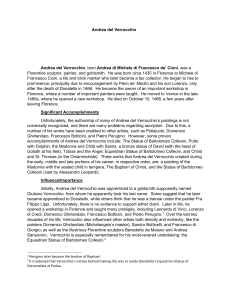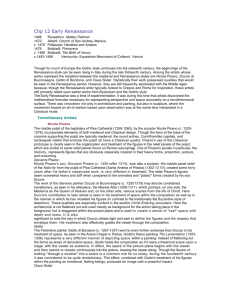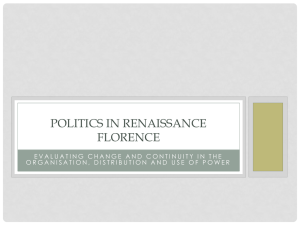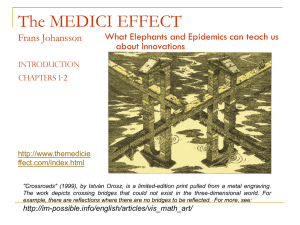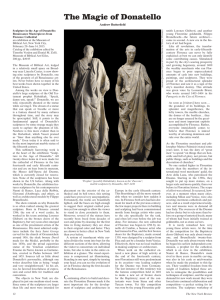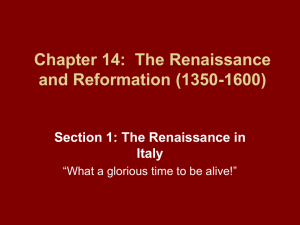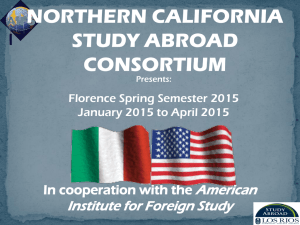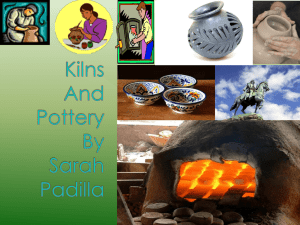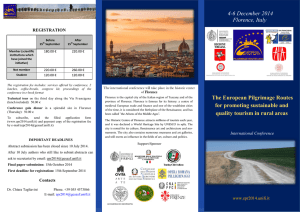Verrocchio - U3A in Swansea
advertisement
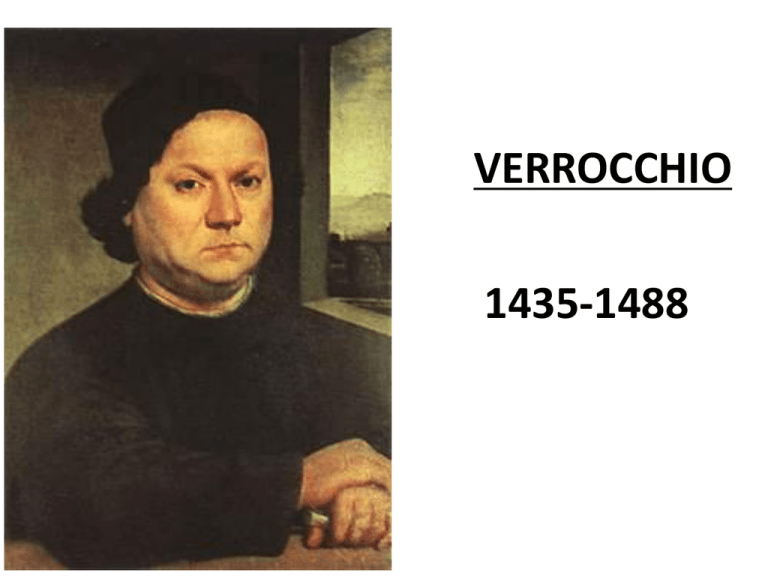
VERROCCHIO 1435-1488 BACKGROUND • Son of a brick and tile maker. • Trained as a goldsmith, became a painter and draftsman but is considered principally a sculptor. • Financial insecurity was always a family problem and he had to support many of his siblings. • There is a general assumption that he and Botticelli worked together under the master Fra Filippo Lippi. • He had a studio in Florence and became a member of the Guild of St Luke. • He worked in the court of Lorenzo de Medici. • None of his works as a goldsmith have survived. • Few of his paintings and sculptures can totally or definitely be attributed to him. • However his reputation was widespread in the second half of 15th century and many of the well known artists of the Italian Renaissance studied painting and sculpture at his Florentine Studio. • Leonardo da Vinci (1458-1537) and Lorendo da Credi (1452-1519) were apprenticed to him and his influence on the Florentine school of artists is considered profound. • Apart from Leonardo da Vinci another important student of his Florentine workshop was Perugino who was later to be Raphael’s teacher. • He has been attributed as being the most influential Florentine of the second half of the 15th Century. MOTIVATION/AIMS. PATRONAGE/OBJECTIVES. • His rise to artistic prominence was due to encouragement by Piero de Medici and his son Lorenzo. • This appears to have begun after the death of the sculptor Donatello in 1466 (who had been the Medici favourite). • He produced paintings and sculptures and also designed costumes and decorative armour for Medici festivals, tournaments and solemn receptions. • He was made curator of the collection of antiquities in the Medici palace. • He restored many pieces of ancient roman sculpture especially portrait busts. WORKS • None of his works as a goldsmith are considered to have survived. • His paintings are often considered difficult to attribute totally to him. He is known to have worked in oils, tempera ,charcoal and pen and ink. • His sculptures also are not able to be totally attributed to him. He is known to have worked in clay, bronze and terracotta. Paintings/ Drawings • The following five paintings and one drawing are those often discussed in relation to Verrocchio. • The first three are all of Madonna and child. • The fourth is Tobias and The Angel. • The fifth is The Baptism of Christ. • The drawing is Head of Woman. MADONNA WITH CHILD 1468-70. Gemaldegalerie Berlin. Considered an early work. 1470-75. Metropolitan Museum .New York. Considered to be based on a design by him. VIRGIN AND CHILD WITH ANGELS 1467 -69. National Gallery. London. VIRGIN AND CHILD WITH ANGELS. 1467-69. National Gallery. London. This painting was not attributed to him until 2010 following restoration at the national gallery London. TOBIAS AND THE ANGEL. 1470-80. National Gallery. London. This was probably painted as a private devotional picture. This was formally attributed to Pollainolo and others. • BAPTISM OF CHRIST 1474-75. • Uffizi. Florence. • This was largely executed by his pupil Lorenzo di Credi. • Accredited to Verrocchio in 1550. • The angel on the right and part of the distant landscape was painted by Leonardo da Vinci. • DRAWING. HEAD OF WOMAN. 1475. • British Museum. • Sketching – charcoal, pen and brown ink. • Verrocchio credited with inventing this type of ideal beauty generally associated with Botticelli. SCULPTURES • The following sculptures are those commonly described. • His sculpture of David is compared and contrasted with Donatello’s sculpture of David. • His sculpture of Condottiero Colleoni is also compared and contrasted with Donatello’s Condottiero Gattemelata. • DAVID. 1460’s Florence. • Bronze statue of a young man modestly clad commissioned by Piero de Medici. • It has been suggested that the new young apprentice Leonardo da Vinci was his model. DAVID (by Donatello 1440). Florence. • This scantily clad youth contrasts with Verrocchio’s modestly clad David. • This bronze was also commissioned by the Medici family some twenty years earlier. DAVID VERROCCHIO’S DONATELLO’S CHRIST AND ST. THOMAS. 1467-83. Florence. • Bronze group commissioned by the guilds of Florence for the centre tabernacle on the east facade of a Florentine church to replace a statue of Louis of Toulouse which had been removed. • He had to place two statues (life size) in a space designed for one. • This bronze is noted for its technical perfection, composition and design and his understanding of the emotional nature of the subject. • Considered a masterpiece from its unveiling. PUTTO. (Winged boy with dolphin.)1465-80. Florence. • Intended for a festival in a Medici villa. • Sometimes called a cupid and it is considered to be precisely balanced in the projection of its limbs. • It is important for its spiral design which allows for all views to be of equal significance. • It was probably initially placed on a fountain so that it could be turned by the pressure of streams or jets of water. • Brought to Florence in the mid sixteenth century by Cosimo de Medici. • It was reinstalled on top of a fountain designed for a courtyard in Florence. • Now in Florentine museum. CONDOTTIERO COLLEONI. 147988. Venice. • Bartolomeo Colleoni, professional soldier died. • Large part of his estate was left to the Venetian Republic on condition they commission a statue of him. • A competition was arranged to choose a sculptor. • Three competed and Verrocchio won. • He then opened another studio in Venice. • He made the final clay model ready for casting in bronze. • He died in 1488 before completion. • Alessandro Leopardi (one of his competitors in the commissioning selection process) did the casting and polishing to complete the sculpture. • Erected in Venice in 1496. ANOTHER VIEW OF COLLEONI. • It has been suggested that the movement of the horse and the commanding gaze of Colleoni gives the impression that the warrior is riding into battle at the head of his troops who press behind. • It is considered that the soldier and his horse have become the embodiment of will power, as well as a purposeful and ruthless machine. • It is considered to have been contrived with great technical assurance and was modelled with power and sensitivity. • It is said that it was unlikely that he ever met Colleoni and the statue is unlikely to be a portrait of the man but rather the idea of a strong and ruthless military commander. • It is argued that this work shows the individuality of his achievement. CONDOTTIERO GATTEMELATA (DONATELLO 1453) Padua • This statue was sculpted some thirty years before Verrocchio’s Colleoni. • Donatello’s statue was considered to have an air of calm command. • Verrocchio’s statue was considered to show movement and a sense of strain and energy. CONDOTTIERO VERROCCHIO’S COLLEONI DONATELLO’S GATTAMELATA BUST OF LORENZO DE MEDICI. 1485. Washington DC. USA. • His versatility is further seen in his portraiture. • This bust was made in terracotta. BUST OF A WOMAN HOLDING A POSY. 1475-80. Florence. • The folds of the woman's dress are considered the work of a master sculptor. • The head looks out and slightly upwards and the hands are placed irregularly on the breast. • The hands are the first to be shown in a portrait bust. • The Florentines admired the beauty of her hands and considered that they have a quality that transcends joints. • Botticelli would immortalize the same quality in his paintings LEGACY • Verrocchio's versatility was considered unique even in a time when artists were proficient in most media and techniques. • The study of contrasting expressions and Leonardo da Vinci's twisting pose (figura serpentinata) originate with Verrocchio. • We have seen examples of this twisting movement in both his sculptures, “Putto with Dolphins” and “The Colleoni” monument. • His Colleoni statue is considered to be aesthetically the most important equestrian statue of the Renaissance. • It was considered an innovative, scenic, graphic conception which was influential in the development of equestrian figures, from the Baroque period of the seventeen century to those produced in the nineteenth century by sculptors of the Romantic style. • He obviously was highly thought of and perhaps he contributed greatly to the phrase we use today,” the renaissance man”! Accreditations • The Art Book - Phaidon. • Encyclopaedia Britannica – Gunter Passavant • Eyewitness Companions Art –Robert Cummings. • National Gallery. London • The Thames and Hudson Dictionary of Art and Artists. • Wikipedia
